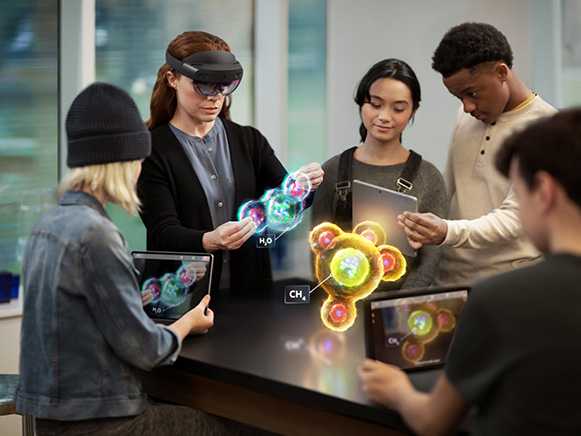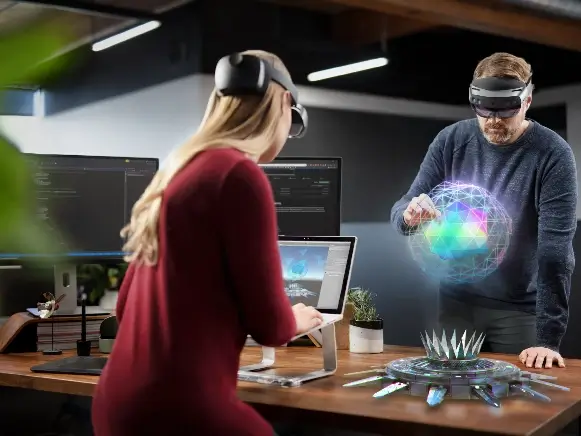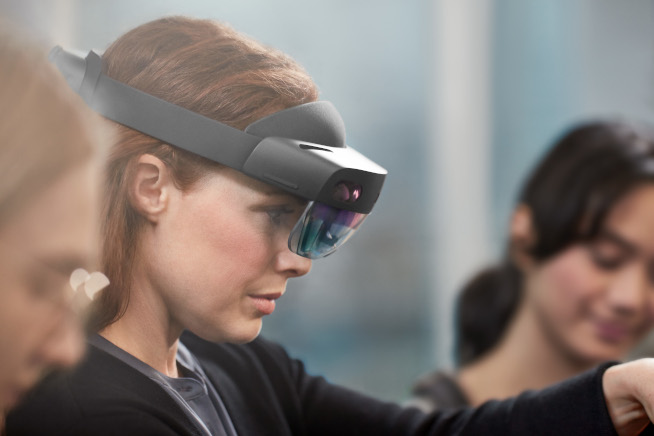HoloLens 2 in education
The importance of digitization has long been underestimated, especially in the education sector. Not least, the Corona pandemic has prompted a long overdue rethink. But the opportunities offered by digital learning methods go far beyond laptops and the Internet. Education is virtually predestined for the use of augmented reality. New technologies help to impressively convey teaching content and relieve teachers.
What can the HoloLens 2 do in teaching and research?
To bring AR and VR into the classroom, teachers and students need a powerful, robust and intuitive system. Applications for Windows 10 Augmented Reality, for example, have the advantage that most teachers and students also have the operating system on their home computers or are at least familiar with it. This means that content can be prepared, taught and communicated intuitively.
The use of augmented reality is currently primarily about supplementing and supporting teaching and not about doing away with real teachers. In fact, in teaching and research, the HoloLens 2 can greatly extend the reach of a lecture or lesson regardless of space.
Although AR content can already be displayed on almost any smartphone or tablet computer, the use of a headset suitable for everyday use is the better solution. Fatigue-free wearing even over longer periods of time, free hands for taking notes or participating, and spatial flexibility through wireless communication are just some of the advantages of the HoloLens 2, which is not just an accessory, but a full-fledged computer system.
With HoloLens 2 learning programs, the possibilities for modern teaching are very diverse. If everyone wears a HoloLens 2 in the classroom, a joint virtual excursion to the dinosaurs is just as possible as the presentation of a molecule that can be viewed and explained from all sides in the form of 3D holograms.
Particularly in the case of complex content in the natural sciences, which can only be explained inadequately on the classic two-dimensional blackboard, the HoloLens 2 in education offers the possibility of making lessons interactive. This makes the teaching of learning content not only more modern and pretty to look at, but also more sustainable. Through immersive immersion in the content, HoloLens 2 learning programs can contribute to more effective knowledge absorption.
PLANSYSTEME
DO YOU HAVE ANY QUESTIONS? FEEL FREE TO CONTACT US!
Do not hesitate to contact us. In a first non-binding conversation we will find out how we can help you and whether our solutions fit you. We look forward to hearing from you!
Not only useful in the classroom
Headsets like the HoloLens 2 will not only be indispensable in the classroom in the future. Augmented reality systems are also already in widespread use at universities and other institutions for further education and training. In any case, it is important that the technology keeps pace with developments and remains future-proof in the medium term.
After all, the acquisition and maintenance of VR and AR systems, including up-to-date content, must remain economically viable. The HoloLens 2 is a robust and at the same time fully marketable solution that, unlike many niche products, will continue to be supported in the future.
At the same time, the content must be oriented to the curricula and specifications of the educational institutions and educational providers, and it must be possible to adapt it flexibly.
Conclusion: Efficient methodology and not a toy – the HoloLens 2 in education
In the field of education, augmented reality is one of the most innovative and particularly efficient methodologies for conveying learning content. It is important that decision-makers and other stakeholders understand that this is not a simple gimmick, just because content can also be conveyed in a playful way.
Rather, it is an opportunity to create an interactive and immersive learning experience that generates interest in the content, skillfully integrates modern technologies, and achieves sustainable learning success. In terms of costs, the investments, which are certainly high at the beginning, are offset by the benefits that widespread use ultimately brings. In addition, other expensive learning tools can be saved elsewhere.
Augmented reality is already available today through the compatibility of many systems with common tablets and smartphones. Headsets like the HoloLens 2, on the other hand, integrate AR ergonomically and without frictional losses directly into everyday learning.




